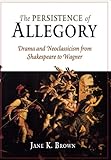The Persistence of Allegory : Drama and Neoclassicism from Shakespeare to Wagner / Jane K. Brown.
Material type: TextPublisher: Philadelphia : University of Pennsylvania Press, [2013]Copyright date: ©2007Description: 1 online resource (304 p.) : 21 illusContent type:
TextPublisher: Philadelphia : University of Pennsylvania Press, [2013]Copyright date: ©2007Description: 1 online resource (304 p.) : 21 illusContent type: - 9780812239669
- 9780812201475
- 809.15 22
- PN1811 .B76 2007eb
- online - DeGruyter
- Issued also in print.
| Item type | Current library | Call number | URL | Status | Notes | Barcode | |
|---|---|---|---|---|---|---|---|
 eBook
eBook
|
Biblioteca "Angelicum" Pont. Univ. S.Tommaso d'Aquino Nuvola online | online - DeGruyter (Browse shelf(Opens below)) | Online access | Not for loan (Accesso limitato) | Accesso per gli utenti autorizzati / Access for authorized users | (dgr)9780812201475 |
Browsing Biblioteca "Angelicum" Pont. Univ. S.Tommaso d'Aquino shelves, Shelving location: Nuvola online Close shelf browser (Hides shelf browser)

|

|

|

|

|

|

|
||
| online - DeGruyter The Afterlife of Character, 1726-1825 / | online - DeGruyter A Novel Marketplace : Mass Culture, the Book Trade, and Postwar American Fiction / | online - DeGruyter Tramps, Unfit Mothers, and Neglected Children : Negotiating the Family in Nineteenth-Century Philadelphia / | online - DeGruyter The Persistence of Allegory : Drama and Neoclassicism from Shakespeare to Wagner / | online - DeGruyter Profound Science and Elegant Literature : Imagining Doctors in Nineteenth-Century America / | online - DeGruyter Looking Inward : Devotional Reading and the Private Self in Late Medieval England / | online - DeGruyter Fairy Tales and Society : Illusion, Allusion, and Paradigm / |
Frontmatter -- Contents -- Preface -- Chapter 1. Introduction -- Chapter 2. Claude's Allegories and Literary Neoclassicism -- Chapter 3. Secular Tragedy: Neoclassicism in the Sixteenth Century -- Chapter 4. Allegory and Passion: Latin Dramatic Forms in the Seventeenth Century -- Chapter 5. The Allegorical Idioms of the Illusionist Stage: Spectacle in the Seventeenth Century -- Chapter 6. Opera and Dance: The Revival of Greek Tragedy -- Chapter 7. The Greek Revival: German Classicism and the Recovery of Spoken Drama -- Chapter 8. Wagner and the Death of Gesamtkunstwerk -- Coda: "This Insubstantial Pageant" -- Notes -- Works Cited -- Index
restricted access online access with authorization star
http://purl.org/coar/access_right/c_16ec
In an impressively comparative work, Jane K. Brown explores the tension in European drama between allegory and neoclassicism from the sixteenth through the nineteenth century. Imitation of nature is generally thought to triumph over religious allegory in the Elizabethan and French classical theater, a shift attributable to the recovery of Aristotle's Poetics in the Renaissance. But if Aristotle's terminology was rapidly assimilated, Brown demonstrates that change in dramatic practice took place only gradually and partially and that allegory was never fully cast off the stage. The book traces a complex history of neoclassicism in which new allegorical forms flourish and older ones are constantly revitalized. Brown reveals the allegorical survivals in the works of such major figures as Shakespeare, Calderón, Racine, Vondel, Metastasio, Goethe, and Wagner and reads tragedy, comedy, masque, opera, and school drama together rather than as separate developments. Throughout, she draws illuminating parallels to modes of representation in the visual arts.A work of broad interest to scholars, teachers, and students of theatrical form, The Persistence of Allegory presents a fundamental rethinking of the history of European drama.
Issued also in print.
Mode of access: Internet via World Wide Web.
In English.
Description based on online resource; title from PDF title page (publisher's Web site, viewed 24. Apr 2022)


